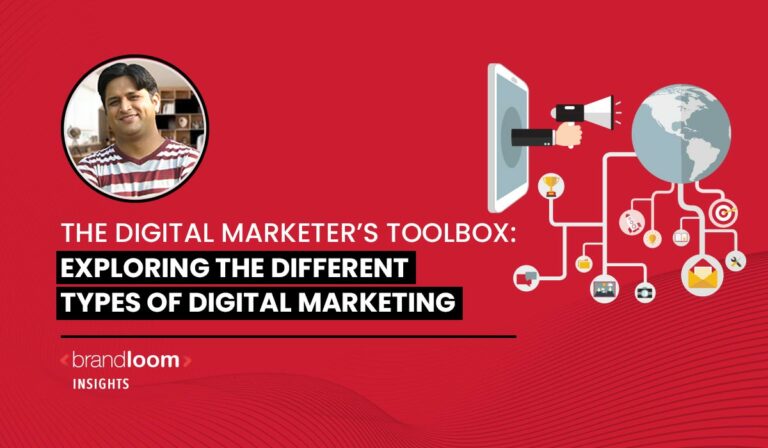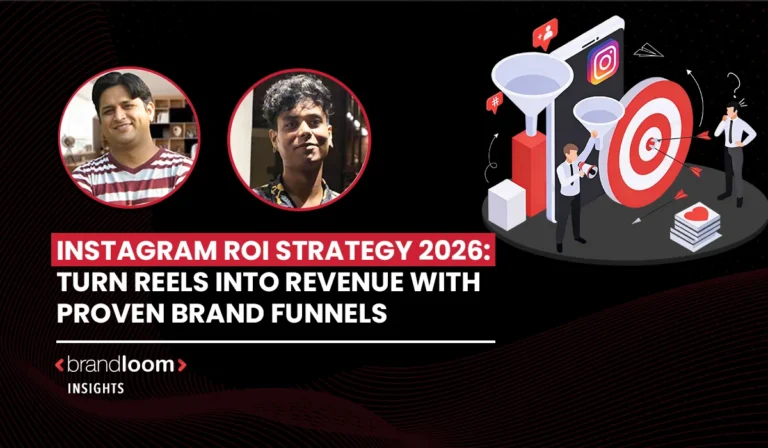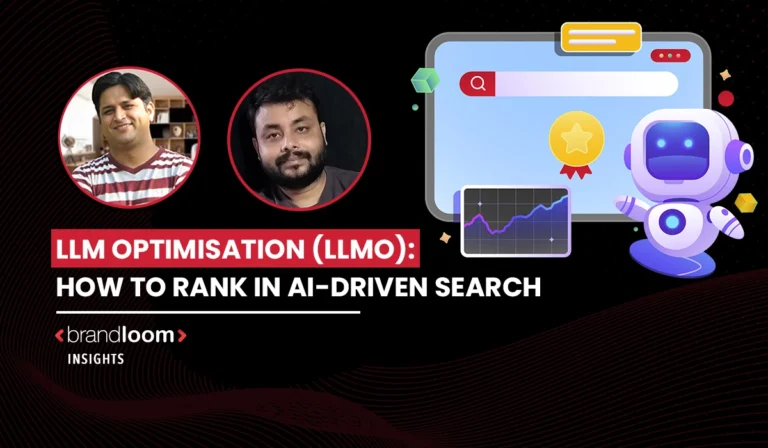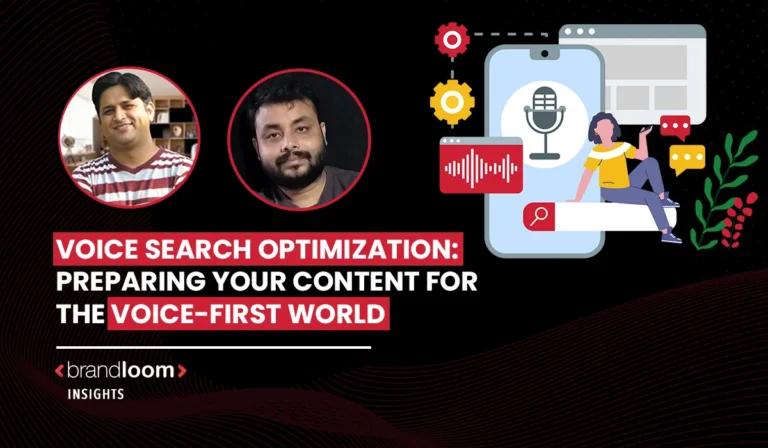The old days when one read news from the newspaper, heard songs from the radio, and watched movies in the theatre; are gone. Today we do everything digitally and, more often than not, online.
In this age of modernity, advertising has seen its new advent with the introduction of digital marketing.
Digital devices and social media have transformed marketing in recent years.
In today’s world, there is a great need for digital marketing to grow your business.
Businesses no longer rely solely on radio commercials, billboards, and print and paid advertisements but instead reach their target audiences through content, email, social media, and other forms of digital marketing.
There are 8 different types of Digital Marketing from which you can select the perfect match for your business.
Choosing the right type of digital marketing technique can be difficult.
So here, we have tried to explain the different types of digital marketing so that choosing the right type becomes simple for you.
What is Digital Marketing?
With digital marketing, a Marketing specialist can use any form of marketing that uses electronic devices to convey promotional messaging and measure its impact throughout your user’s journey.
Digital marketing typically refers to marketing campaigns on a computer, phone, tablet, or other electronic device.
In modern terms, digital marketing involves online marketing, such as video, search engine marketing, display ads, paid ads, and social media marketing. It is frequently contrasted with “traditional marketing” methods such as magazine ads, billboards, and direct mail. Surprisingly, television is commonly associated with traditional marketing though it uses digital channels.
A digital marketing strategy lets you connect with existing customers and individuals interested in your products or services by leveraging various digital channels. As a result, you can create a brand, provide an excellent customer experience, attract new customers, and much more.
Looking for the Best Digital Marketing Agency in Mumbai, Contact us Today!
How to Do Digital Marketing?
The process of digital marketing is straightforward, although there are different types of digital marketing.
First, you must define your digital marketing goals or what you hope to achieve through digital marketing. Examples include raising brand awareness, increasing sales, and expanding your community.
Then it helps you decide which marketing channels will help you achieve your objectives. For example, running paid campaigns on Google and Facebook is an extremely good place to start if your goal is to increase sales.
To make the entire process easier to manage, you can create a plan that specifies how much money you’ll spend, defines your target audience, defines your performance metrics, and other information that will assist you in controlling the entire process.
This is what a good digital marketing campaign is all about. Don’t worry if this still needs to be clarified; there is a more detailed example of creating a successful digital marketing campaign near the end of this post.
Before you launch your first digital marketing campaign, you should be familiar with the various marketing channels and how they operate.
There can be many different types of digital marketing, but there are 8 major types.
Looking for the Best Digital Marketing Agency in Bangalore, Contact us Today!
Different Types of Digital Marketing – How Many Types of Digital Marketing
There are mainly 8 different types of digital marketing. If you are a business or a digital marketing enthusiast or from a digital marketing business, you must know all the available options and tools you can choose from.
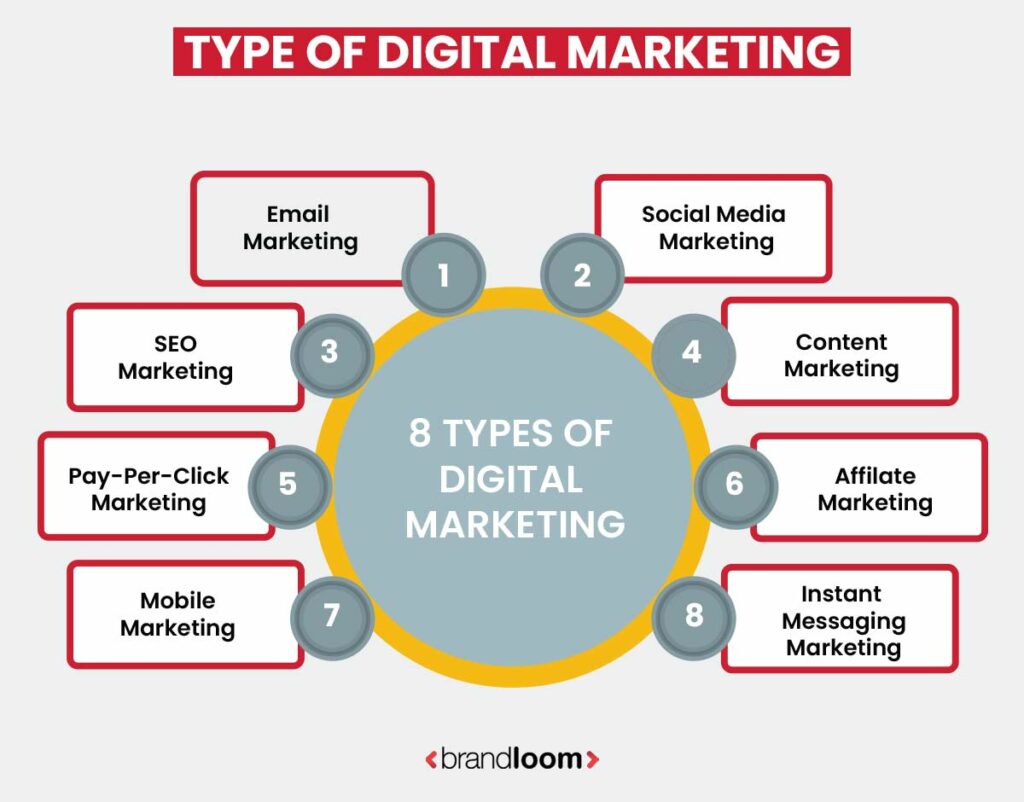
1 Email Marketing
Despite the rise of social media, mobile applications, and other channels, email remains one of the most effective marketing tools.
It can be used as part of a content marketing strategy to provide value to consumers and eventually convert them into customers.
In reference to the American Marketing Association, email marketing professionals understand how to create compelling campaigns and optimal audience outreach.
They are skilled at analyzing all customer interactions and data associated and making strategic decisions based on that data. Email marketing is one kind of online marketing.
Many people associate email marketing with the hundreds of spam emails we receive daily, but that is not the case. Email marketing is a great way to reach out to potential customers or people interested in your brand because they want to hear from you, and you are not spamming their inboxes.
Many successful online businesses and marketers use all other digital marketing channels to acquire leads for their email lists and then use email marketing to convert those leads into customers.
Advantages of Email Marketing
- Businesses can use email marketing to keep customers up to date on new products and promotions. It also informs customers when a company is running a promotion or having a sale.
- Emails have the potential to feel more personal than other forms of digital marketing. Customers prefer receiving regular updates in their inboxes rather than being bombarded with advertisements.
- Customers may find emails a good balance, as phone calls and text messages can be too intrusive.
- Those who sign up for email subscriptions are more likely to become frequent visitors to a website and then become customers of products.
- When buyers become regular buyers, they can be categorized with other buyers who share similar interests, allowing email messages to be tailored to each buyer segment.
Disadvantages of Email Marketing
- In-person customers may prefer paper receipts over digital receipts.
- Customers concerned about receiving an excessive number of unnecessary emails
- Customers might be hesitant to share their email ids.
- Customers frequently need to open emails.
- Finding ways to add value to keep customers from unsubscribing becomes difficult.
Looking for Email Marketing Services Company for your Business, contact us Now!
2 Search Engine Optimisation
Search engine optimization (SEO) is another important and efficient type of digital marketing for promoting a product or business.
According to Search Engine Journal, SEO optimizes a website and its high-quality content to achieve higher visibility in search engine results.
SEO is critical because many consumers shop online using search engines like Google.
When they enter specific keywords or phrases, the search engine generates results based on those particular keywords or phrases.
In reference to Backlinko, the top Google search result has a 31.7% click-through rate.
SEO aims to raise a company’s ranking in Google search results, increasing search engine traffic to the company’s website.
To accomplish this, SEO marketers investigate the words and phrases consumers use to search for information online and incorporate those terms into their content.
SEO encompasses many elements, ranging from the comments on your web pages, how other sites link to you, and how your website is structured.
Types of SEO in Digital Marketing
The following are the types of SEO in digital marketing:
- On-page SEO: Refers to optimising the website content, structure and meta tags to improve relevance and visibility in search engine results.
- To improve search engine visibility, technical SEO optimises a website’s technical elements, such as site speed, mobile optimization, and security.
- Local SEO optimises a local business’s website to rank higher in local search results.
- Off-page SEO refers to optimising factors outside a website, such as backlinks, social media signals and online reviews, to improve search engine ranking.
Advantages of Search Engine Optimisation
- SEO optimizes visibility with unpaid, organic search results.
- SEO leads traffic to relevant sites with specific keywords.
- SEO changes according to the changing demands of the customer.
- SEO helps establish and maintain an online clientele.
Disadvantages of Search Engine Optimisation Marketing
- SEO is dependent on both content and technology.
- Google’s ever-changing algorithms may thwart your efforts.
- SEO takes time to produce results.
- SEO algorithms are always changing; therefore, no SEO strategy can be absolute.
If you are looking for a professional SEO Agency for your Business, contact us now!
3 Social Media Marketing
Social media marketing drives traffic and brand awareness by engaging people in online discussions.
You can always use social media marketing to highlight your brand, services, culture, products, and more.
Billions of people are constantly online. Thus, focusing on social media marketing can be beneficial.
Facebook, Twitter, and Instagram are the most popular digital platforms for social media marketing, with LinkedIn and YouTube not far behind.
Finally, your objectives and target audience determine the social media sites you can use for your business. e.g. if you want to find new leads for your Tech startup, targeting your audience on LinkedIn is a good idea because professionals are very active on the platform.
Running social media ads on Instagram may be better for your brand if you run a B2C focused on younger consumers.
As social media marketing involves active audience participation, it has grown in popularity.
At 96%, it is the most popular content medium for B2C digital marketers and is also gaining traction in the B2B sphere.
This year, according to the Content Marketing Institute, 61% of B2B content marketers increased their use of social media.
Social media marketing includes built-in engagement metrics that can help you understand how well you reach your target audience.
You get to choose which types of interactions are most important to you, whether that’s the number of shares, the number of likes or comments, or the total clicks on your website.
Your social media marketing strategy may not include something other than direct purchases. Many brands use social media marketing to engage audiences rather than immediately encourage them to spend money.
This is especially common in brands catering to older audiences or providing products and services that are not suitable for impulse purchases. Everything is dependent on your company’s social media marketing objectives.
Here are some of the most crucial social media marketing best practices:
- Create high-quality, engaging content and respond to comments and questions professionally.
- Make a schedule for your social media postings.
- Post at the appropriate time
- Employ social media managers to assist your marketing efforts.
- Know your target audience and which social media channels they use the most.
Advantages of Social Media Marketing
- Social media marketing is known to have high conversion rates.
- Your efforts will quickly multiply as people like, comment, and share your content. The more people like and share it, the more widely your post will circulate.
- Facebook/Instagram ads allow you to target specific customer segments and deliver your message to the right people.
Disadvantages of Social Media Marketing
- Social media can be difficult. The algorithm is constantly changing. In addition, new content formats are introduced regularly. You will have to check for updates frequently.
- Although posting on social media appears to be simple, it requires strategic planning and the commitment of sufficient time to do so consistently and efficiently.
Looking for Social Media Marketing Services Company for your Business, contact us Now!
4 Content Marketing
Content marketing raises brand awareness through storytelling and information sharing.
Finally, the goal is for the reader to step toward becoming a customer, such as requesting more information, joining an email list, or making a purchase.
Blog posts, resources such as white papers and e-books, digital videos, podcasts, and other forms of content are all examples of content.
In general, it should provide value to the consumer first and foremost, rather than advertise the brand or try to make a sale.
Content marketing is about developing a long-term, trusting relationship with your customers that can lead to multiple sales over time, not just one.
What is content marketing in digital marketing
Content marketing tactics, as contrasted to PPC, are a long-term strategy.
Marketers build up a database of content (text, video, podcasts, etc.) that will continue to generate users to the site via search engines.
This content library promotes brand awareness and raises your profile as an information resource.
When users visit your site for information, you want them to remember you as an authority when it comes time to buy.
Content marketing is an excellent opportunity for those who enjoy writing and video and audio production.
However, as with all aspects of digital marketing, it necessitates strong strategic and analytic abilities.
Advantages of Content Marketing
- Clients are drawn in by anticipating their desires.
- Maintains customer relationships through consistent communication.
- Customers are informed about sales, coupons, and new products.
- Content is a very versatile option. It allows you to build your brand by educating, entertaining and inspiring your audience.
Disadvantages of Content Marketing
- Because content marketing is such an important aspect of digital marketing, a content marketing team needs to be familiar with SEO or needs to create a strategy for social media posts can be a major disadvantage for the company.
- Another disadvantage may arise if the content marketing team fails to produce consistent and effective content.
- The competition is fierce, and ranking organically for target keywords takes a long time.
- Your content must meet your customers’ needs while branding and achieving your goals. Making the right content takes work, and the writers must be skilled.
If you are Looking for a Content Marketing Services Company for your Business, contact us now!
5 Pay-Per-Click Marketing
Pay-per-click marketing refers to paid advertisements and modified & altered search engine results.
This is a short-term digital marketing technique in which the ad disappears once you stop paying.
PPC, like SEO, is a method of increasing search traffic to a business’s website.
Pay-per-click advertising can refer to advertisements displayed at the top and sides of search results pages, promotions displayed while browsing the web, advertisements before YouTube videos, and advertisements displayed in mobile apps.
Another distinction between pay-per-click and SEO is that you only pay for the results.
In a typical PPC model, such as a Google Ads campaign, you will only pay when someone clicks on your ad when it shows on their screen and visits your website.
Pay-per-click advertising allows you to spend virtually any amount of money.
Some businesses may see results after investing only a few hundred dollars, but many large corporations spend tens of thousands per month on pay-per-click advertising.
The competition for your keywords primarily determines the cost of running an ad or promoting your search results.
High-competition keywords (those that many people search for and for which many sites compete) will be more expensive, while lower-competition terms will most likely be less expensive.
When you create a pay-per-click campaign, you can specify whether you want your ad or promoted results to be shown to users worldwide or only within a specific geographic area.
According to Google, if you are marketing a physical store, the ability to tailor by location allows you to avoid wasting ad dollars by serving ads to users who do not live near your store.
Advantages of Pay-Per-Click Marketing
- PPC marketing has a high ROI and can generate a lot of revenue.
- Customers find the products they’re looking for, businesses sell their products, and search engines profit through PPC marketing.
Disadvantages of Pay-Per-Click Marketing
- PPC marketing has a high ROI and can generate a lot of revenue.
- Targeting popular keywords can often be costly.
- Customers find the products they’re looking for, businesses sell their products, and search engines profit through PPC marketing.
Looking for the Best Digital Marketing Agency in Gurgaon, Contact us Today!
6 Affiliate marketing
Affiliate marketing is a digital marketing strategy that allows people to earn money by promoting the products and services of others.
You could be the promoter or a business that works with the champion, but the process is the same.
It operates on a revenue-sharing model.
If you are the affiliate, you will receive a commission whenever someone purchases the item that you have promoted.
If you are the merchant, you pay the affiliate for each sale they assist you in the making.
Some affiliate marketers prefer to review only one company’s products, perhaps on a blog or another third-party site. Others have multiple merchant relationships.
The first step, whether you want to be an affiliate or find one, is to connect with the other party. You can start or join a single-retailer program or use digital channels designed to connect affiliates with retailers.
Anyone can do many things as a retailer to make your program appealing to potential promoters if you work directly with affiliates.
You must provide those affiliates with the tools they require to succeed. This includes both incentives for excellent results and marketing tools and pre-made materials.
Advantages of Affiliate marketing
- Affiliate marketing benefits both businesses and affiliates because both profit from the product.
- Affiliates can choose how much they want to work and earn as much or as little as they wish.
- Businesses can also collaborate as affiliates with other firms. Companies can profit from promoting each other’s products in these situations.
- You have access to the influencer’s existing audience. So you don’t have to wait to build one yourself.
- Associating with a well-known figure allows you to gain genuine followers and customers.
Disadvantages of Affiliate marketing
- Affiliates may generate less revenue than expected.
- An affiliate campaign must be consistent with brand identity or official marketing strategies.
- It’s more than just paying a lot to work with influencers. It would help if you chose the right influencer marketing strategy based on your audience and brand and figured out authentic ways to collaborate with them.
- Influencers are increasingly distrusted, so you must be cautious and transparent when paying them for promotions.
Looking for the Best Digital Marketing Agency in Pune, Contact us Today!
7 Mobile Marketing
This type of digital marketing focuses on reaching your target audience via their smartphone or tablet.
People are reached by mobile marketing through text messages, social media, websites, email, and mobile applications.
Marketers can tailor offers or certain content to a specific geographic location or time, such as when a customer enters a store or attends an event.
Statista surveyed in February 2022, and 46% of respondents said they spend five to six hours daily on their phones for personal use.
Furthermore, 22% said they spend more than 3 hours daily on their phone.
According to Google research, 27% of people use mobile voice search worldwide. The portable consumer journey is rapidly expanding.
Digital marketing necessitates both immediacy and loyalty, and smartphones are one of the most immediate problem-solving partners available anywhere, at any time.
E-commerce has grown tremendously recently, becoming an important component of the global retail world.
According to Statista, 70% of all retail website visits in 2021 will be from smartphone users, and e-commerce sales will have increased by more than 4.2 trillion dollars in 2020.
Marketers understand the importance of taking your message to where your customers are, and the evidence is clear: your potential customers are on their phones.
Advantages of Mobile Marketing
- Allows businesses to reach out to people who may not own computers but do own cell phones.
- It can help businesses that provide services rather than products, such as receiving a push notification from a user’s gym when driving by a new location.
- Can assist local businesses in engaging with their customers and bringing them into physical stores.
- Customers now spend more time on their mobile phones than desktops/laptops. As a result, mobile marketing assists in reaching them where they spend the majority of their time.
- It can be geo-targeted or tailored to specific audience segments.
Disadvantages of Mobile Marketing
- While mobile device marketing can reach inactive internet users, they are less likely to shop online.
- Unwanted phone calls to a mobile device can be annoying.
- When compared to computers, the space is limited.
- The click rate on mobile ads is low.
- When people communicate, they frequently dislike being interrupted by marketing messages.
8 Instant Message Marketing
Businesses can use instant message marketing to reach current or potential customers via SMS, WhatsApp, Instagram direct message, and Facebook Messenger.
Like email marketing, instant message marketing can aid in the development of a customer contact list.
Advantages of Instant Message Marketing
- One of the advantages of instant message marketing is that it provides businesses with a list of customers to whom they can send special coupons, sales, and new product promotions regularly.
- Another advantage of text messaging over phone calls for mobile device marketing is that people are more likely to skim through a text than answer a phone call from an unknown number.
Disadvantages of Instant Message Marketing
- Unwanted messages from businesses can feel intrusive.
- There is a lower likelihood of an immediate return on investment.
9 Influencer Marketing
Influencer marketing is a type of digital marketing that involves partnering with individuals with a large social media following to promote products or services to their followers.
This type of marketing leverages the personal connection and trust that influencers have built with their audience to reach a wider and more targeted audience.
Influencer marketing can be a highly effective way to reach potential customers and increase brand awareness. Still, choosing influencers who align with your brand values and whose audience is a good match for your target market is important.
It’s also crucial to have a clear and transparent relationship with influencers to ensure the authenticity of their endorsement.
Advantages of Influencer Marketing
- Reach: Influencer marketing allows businesses to reach a wider and more targeted audience through the influencer’s influence.
- Trust: Influencers have built a personal connection and trust with their followers, making their endorsement more valuable and credible.
- Authenticity: Influencer marketing creates a more authentic connection with potential customers than traditional advertising.
- Increased brand awareness: Working with influencers can increase brand awareness and credibility.
- Cost-effective: Unlike other forms of advertising, influencer marketing can be cost-effective and provide a high return on investment.
- Measurable results: Influencer marketing results can be easily measured and analyzed to evaluate the campaign’s success.
Disadvantages of Influencer Marketing
- High costs: Partnering with popular influencers can be expensive and may not provide a good return on investment.
- Inauthentic partnerships: Some influencer partnerships may be perceived as inauthentic or staged, damaging the influencer’s credibility and the brand’s reputation.
- Misalignment with brand values: Working with influencers who do not align with your values can harm your brand’s reputation.
- Lack of control: Influencers have unique voices and styles that may not align with the brand’s messaging and style.
- Difficulty measuring success: It can be difficult to measure influencer marketing campaigns’ success accurately.
- Regulation challenges: Influencer marketing is subject to regulations and disclosure requirements, which can be difficult to navigate.
Looking for an Influencer Marketing Services Company, connect with us today.
Does Digital Marketing Work For All Businesses?
Digital marketing can benefit any company regardless of the industry.
What your company sells, digital marketing still entails creating buyer personas to identify the needs of your target audience and creating content.
That is not to say that every business should implement digital marketing strategies similarly. The digital marketing process can differ based on the kind of business you are concerned about.
B2B Digital Marketing
Suppose your company is business-to-business (B2B).
In that case, your digital marketing efforts are most likely focused on online lead generation, with the ultimate goal of having someone speak with a salesperson.
Your marketing strategy may aim to attract and convert high-quality leads for your salespeople via your website and digital channels.
Beyond your website, you’ll concentrate on business-focused channels such as LinkedIn, where your target demographic spends their time online.
Looking for the Best Digital Marketing Agency in Delhi NCR, Contact us Today!
B2C Digital Marketing
Depending on the price point of your products, the goal of your digital marketing efforts, if your company is business-to-consumer (B2C), is likely to attract people to your website and have them become customers without ever speaking to a salesperson.
You’re less likely to focus on ‘leads’ in the traditional sense and more likely to create an accelerated buyer’s journey from when someone visits your website to when they buy.
This may imply that your product features are higher up in the marketing funnel than they would be for a B2B company, and you may need to use stronger calls-to-action to encourage purchases.
Instagram and Pinterest are frequently more valuable to B2C companies than business-focused channels like LinkedIn.
How to choose a digital marketing strategy for your business?
Choosing a successful digital marketing strategy would involve something other than experimenting with the latest digital marketing trends or understanding what your customers want. It is instead about data-backed insights.
“The most successful marketers understand that truly scalable digital marketing has evolved into people-based advertising,” said Jess Reilly, the chief marketing officer at Rebel Interactive Group.
Choosing a digital marketing strategy entails creating buyer personas, determining your goals, selecting the appropriate digital marketing tools, and assessing the strategy that you will employ to ensure it is effective.
A good strategist must always incorporate the right digital marketing techniques in the right way to make their plan successful.
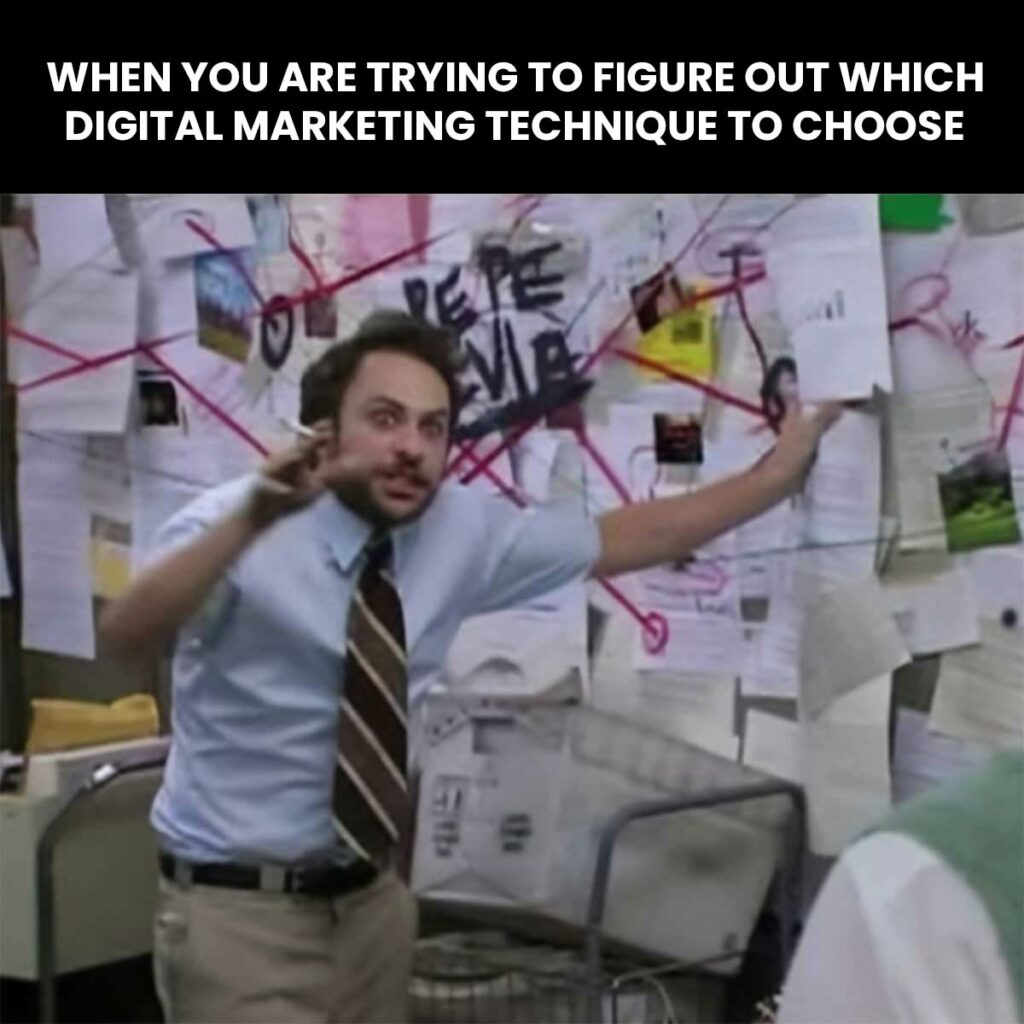
1 Create buyer personas to understand your target audience better.
Buyer personas are fictional characters that represent archetypal consumers who may be interested in your brand. These personas assist you in marketing your goods and services to this demographic. Looking closely at your competitors and how they’re attempting to reach these buyers is one way to get a handle on your target customer.
2 Determine your objectives and match them to your strategy.
What are the objectives of your marketing strategy? For example, you can increase brand awareness, product sales, or social following. To effectively direct your efforts, be specific about your goals.
Aside from using and monitoring hashtags and social media promotion engagement, determining a brand awareness campaign’s return on investment (ROI) takes time.
3 Select digital marketing tools based on your primary objectives.
Content marketing calendar templates, social networks, and email marketing software are examples of marketing tools. Each has distinct advantages and purposes, so your objectives will determine the best tools for you.
Prioritize your objectives and go through your budget to find the best investments. If you’re a long way from a sale, use less expensive tools (such as email and social media posts) because your sales funnel will have a lot of leakages. You can always return to the market and experiment with other tools.
4 Examine your existing digital marketing strategy.
Auditing your digital marketing strategy entails determining what has worked in the past, testing current strategies, and determining what needs to be changed. Some ways you can achieve this are –
- Determine the true ROI of previous efforts.
- Put new strategy to the test.
- Determine what needs to be improved.
This is what digital marketing is all about.
Conclusion
The types of digital marketing available today are vast and diverse. As you have seen, each one offers its own unique benefits and drawbacks.
The challenge for marketers is determining which combination of approaches best aligns with their business goals and target audience.
The key to digital marketing success is continually experimenting, measuring results, and making informed decisions based on data.
As the digital landscape continues to evolve, staying ahead of the curve requires embracing new technologies and techniques.
It’s worth remembering that digital marketing is not just about generating leads and sales; it’s about building relationships.
Creating valuable content and engaging with your audience in meaningful ways can establish a loyal following and cultivate a strong brand reputation.
The beauty of digital marketing lies in its personalization.
With the right strategies in place, you can connect with your target audience in a way that feels authentic and relevant to them. So go out there and unleash your creativity; the world is waiting.
Frequently Asked Questions on Different Types of Digital Marketing
Online marketing is a collection of tools and methods for promoting products and services via the Internet. Because of the additional channels and marketing mechanisms available on the Internet, online marketing includes a broader range of marketing elements than traditional business marketing.
In lay terms, digital marketing integrates digital channels and digital marketing techniques such as SEO, Social Media Marketing, PPC, Email marketing, and many others to attract and convert target audiences to customers.
Digital marketing attracts potential customers to your website or blog and then convinces them to purchase your products. You can use SEO or PPC campaigns to attract your target audience to your website, capture leads, or encourage them to purchase from you.
This interactive connection is the foundation for digital marketing’s four pillars and distinguishes it from non-digital marketing.
They are as follows:
– Content: Provides context for the brand message based on the medium.
– Communication: This is the channel through which messages are exchanged.
– Community: Connects you with other customers and the general public.
– Commerce: Provides currency.
As the Internet evolves, so do the options for online advertising. There are numerous types of advertising available today that can be incorporated into a digital marketing strategy.
As digital advertising evolves, staying current on the latest trends, techniques, and strategy is critical. These various online advertising options can be combined to form a 360° campaign or used separately.
The different types of online advertising are Native Advertising, Display Advertising, Mobile Advertising, Social Ads, Retargeting and Remarketing, Email Marketing, Digital Signage, and Video Marketing.
The marketing industry, like our world, requires key elements to keep spinning. The four key elements of digital marketing are search engine optimization (SEO), email marketing, social media strategy, and Pay-Per-Click (PPC) advertising. Each critical service revolves around a single concept: content marketing. All four approaches complement one another, and when their moving parts work together, they can contribute to a fantastic full-funnel marketing strategy.
A digital advertising strategy promotes a product online. This advertising occurs on social media platforms, search engines, websites, and your inbox. In essence, digital advertising promotes your products or services to people via the Internet. There are various modes of advertising that you can choose from based on your convenience.
Digital marketing is a constantly evolving field that provides businesses with numerous ways to connect with their target audience. Here are some of the most commonly used types of digital marketing:
1 Search engine optimization (SEO): Improving a website’s visibility on search engines like Google.
2 Social media marketing: Leveraging popular platforms such as Facebook and Instagram to reach a wider audience and connect with customers more personally.
3 Email marketing: Reaching customers directly in their inbox with personalized messages.
4 Content marketing: Creating valuable and informative content to attract and retain customers.
5 Pay-per-click (PPC) advertising: A form of digital advertising where businesses pay for each click on their ads.
6 Influencer marketing: Partnering with influencers to promote products or services to their followers.
7 Affiliate marketing: Earning commissions for promoting other businesses’ products.
8 Mobile Marketing
9 Instant Messaging
The beauty of digital marketing lies in its ability to personalize efforts to the specific needs and interests of a target audience. Experimenting with different types of digital marketing and continually measuring results is crucial for staying ahead of the competition.
Visibility with digital marketing is extremely critical for every business today. Depending on your business objective it could mean different things to different people.
It is a constantly evolving landscape and requires a flexible, data-driven and personalized approach to achieve business success.
Personalizing your approach to visibility in digital marketing also involves considering the channels and platforms your target audience is most active on and ensuring that your brand is visible on those.
This could involve leveraging paid advertising, optimizing for voice search, or utilizing new and emerging technologies like virtual and augmented reality.
Additionally, regularly measuring and analyzing the impact of your visibility efforts is essential to make informed decisions and adjusting your strategy as needed.
This could involve tracking metrics such as website traffic, engagement, and conversion rates, as well as monitoring your search engine rankings, social media reach and follower growth.
To summarise, below are some of the key types of visibility in digital marketing:
– Search Engine Visibility: optimizing website content and structure to rank higher in search engine results pages (SERP).
– Social Media Visibility: creating and sharing content on social media platforms to increase brand awareness and reach a wider audience.
– Influencer Visibility: partnering with influential people in your industry to promote your brand.
– Content Visibility: creating and publishing valuable content to attract and engage target audience.
– Local Visibility: optimizing for search engine results in specific geographic locations.
डिजिटल मार्केटिंग के साथ visibility आज हर व्यवसाय के लिए अत्यंत महत्वपूर्ण है। आपके व्यावसायिक उद्देश्य के आधार पर इसका मतलब अलग-अलग लोगों के लिए अलग-अलग हो सकता है।
यह एक निरंतर विकसित होने वाला परिदृश्य है और व्यावसायिक सफलता प्राप्त करने के लिए एक लचीले, डेटा-चालित और व्यक्तिगत दृष्टिकोण की आवश्यकता होती है।
डिजिटल मार्केटिंग में visibility के लिए अपने दृष्टिकोण को personalised करने में उन चैनलों और प्लेटफार्मों पर विचार करना भी शामिल है जिन पर आपके target customers सबसे अधिक सक्रिय हैं और यह सुनिश्चित करना है कि आपका ब्रांड उन पर दिखाई दे।
इसमें paid advertising का लाभ उठाना, voice search के लिए अनुकूलन करना, या VR or AR जैसी नई और उभरती हुई तकनीकों का उपयोग करना शामिल हो सकता है।
इसके अतिरिक्त, आपके visibility प्रयासों के प्रभाव को नियमित रूप से मापना और विश्लेषण करना सूचित निर्णय लेने और आवश्यकतानुसार अपनी रणनीति को समायोजित करने के लिए आवश्यक है।
इसमें ट्रैकिंग मेट्रिक्स जैसे वेबसाइट ट्रैफ़िक, सगाई दर और रूपांतरण दर शामिल हो सकते हैं, साथ ही साथ आपकी खोज इंजन रैंकिंग, सोशल मीडिया पहुंच और अनुयायी वृद्धि की निगरानी भी हो सकती है।
नीचे सारांशित करने के लिए डिजिटल मार्केटिंग में दृश्यता के कुछ प्रमुख प्रकार हैं:
– खोज इंजन दृश्यता: खोज इंजन परिणाम पृष्ठों (SERP) में उच्च रैंक के लिए वेबसाइट की सामग्री और संरचना का अनुकूलन करना।
– सोशल मीडिया दृश्यता: ब्रांड जागरूकता बढ़ाने और व्यापक दर्शकों तक पहुंचने के लिए सोशल मीडिया प्लेटफॉर्म पर सामग्री बनाना और साझा करना।
– इन्फ्लुएंसर दृश्यता: अपने ब्रांड को बढ़ावा देने के लिए अपने उद्योग में प्रभावशाली लोगों के साथ साझेदारी करना।
– Content visibility: लक्षित दर्शकों को आकर्षित करने और संलग्न करने के लिए मूल्यवान सामग्री बनाना और प्रकाशित करना।
– स्थानीय दृश्यता: विशिष्ट भौगोलिक स्थानों में खोज इंजन परिणामों के लिए अनुकूलन।
Digital marketing channels refer to how businesses can reach their target audience online. Here are some of the main types of digital marketing channels:
1 Search Engine Marketing (SEM): Paid advertising on search engines like Google and Bing.
2 Social Media Marketing (SMM): Promoting products or services on social media platforms such as Facebook, Twitter, Instagram, etc.
3 Content Marketing: Creating and sharing valuable content to attract and engage a target audience.
4 Email Marketing: Sending targeted emails to a list of subscribers to build relationships and drive conversions.
5 Affiliate Marketing: Partnering with other businesses to promote their products or services.
6 Influencer Marketing: Partnering with influencers to promote a product or service to their followers.
7 Video Marketing: Creating and sharing video content to engage with the target audience and build brand awareness.
8 Mobile Marketing
9 Instant Messaging Marketing
The key to a successful digital marketing strategy is choosing channels that align with your business goals and target audience. A personalized approach to channel selection can help you reach your target audience effectively and achieve the desired results.
For example, a B2B company might find that LinkedIn and email marketing are the most effective channels for reaching its target audience. In contrast, a B2C company might find that social media and video marketing are the most impactful. Regularly testing and optimizing your channels can also help you improve your results and reach your goals.
The types of content used in digital marketing vary based on the goals and target audience of a particular campaign or strategy.
Here are some of the main types of content in digital marketing:
– Blog Posts: Informative articles that provide valuable insights and information to a target audience.
– Videos: Engaging visual content that can be used to demonstrate products, tell stories or provide tutorials.
– Infographics: Visual representations of data and information that make complex ideas easy to understand.
– Images: Engaging and attention-grabbing images that can be used to tell a story or promote a product.
– Social Media Posts: Short-form content used to engage with followers and build a brand on social media platforms.
– E-books: Long-form content that provides in-depth information and insights on a specific topic.
– Case Studies: Detailed accounts of how a product or service has helped a particular customer or business.
When creating content for digital marketing, it is important to consider the format, tone and style that will resonate with your target audience. A personalized approach to content creation can help you effectively communicate your message and achieve your goals.
For example, a B2B company might find that in-depth e-books and case studies are the most effective for building trust and demonstrating expertise. In contrast, a B2C company might find that engaging videos and social media posts are the most impactful for building brand awareness and driving conversions.
Ultimately, the key to successful content marketing is understanding your target audience and creating content that meets their needs and interests.

